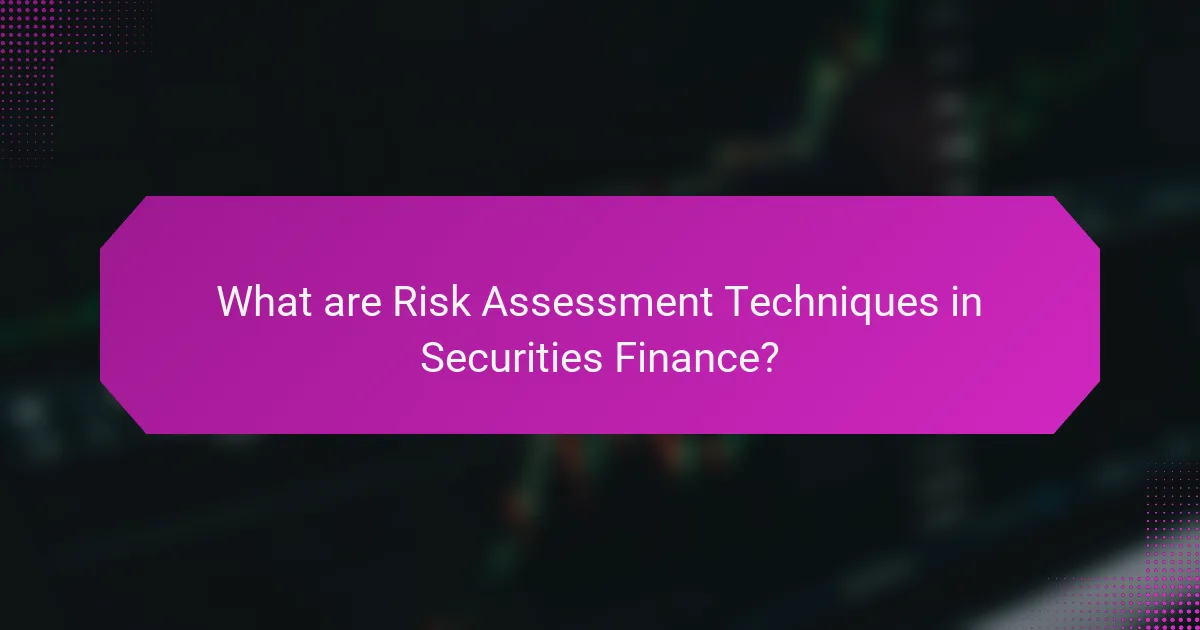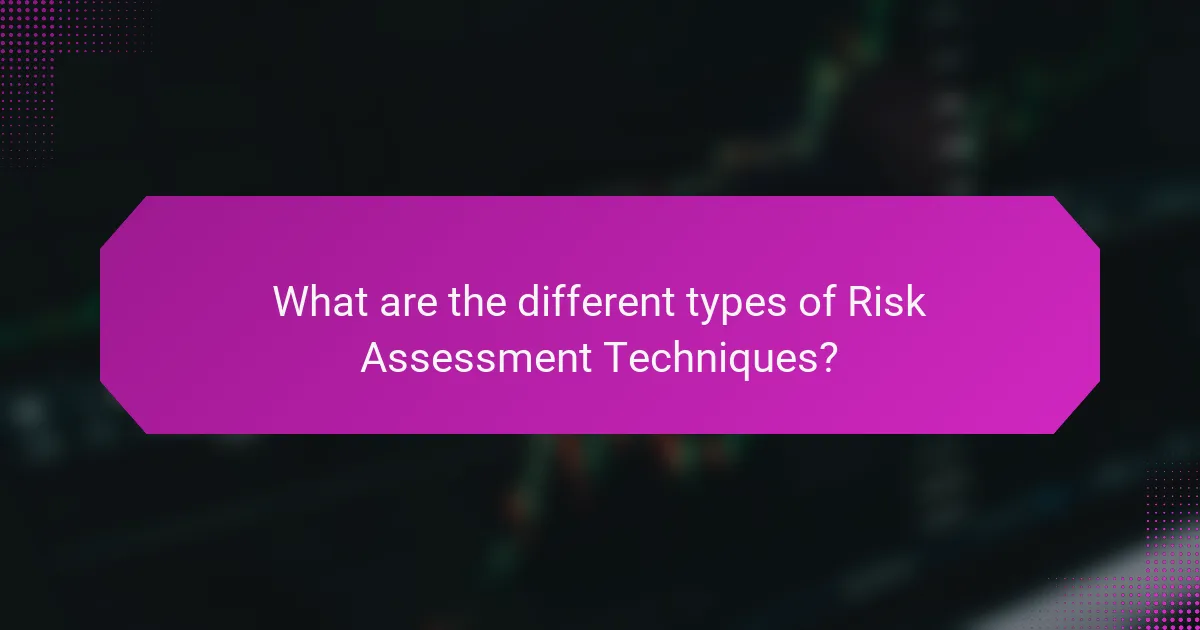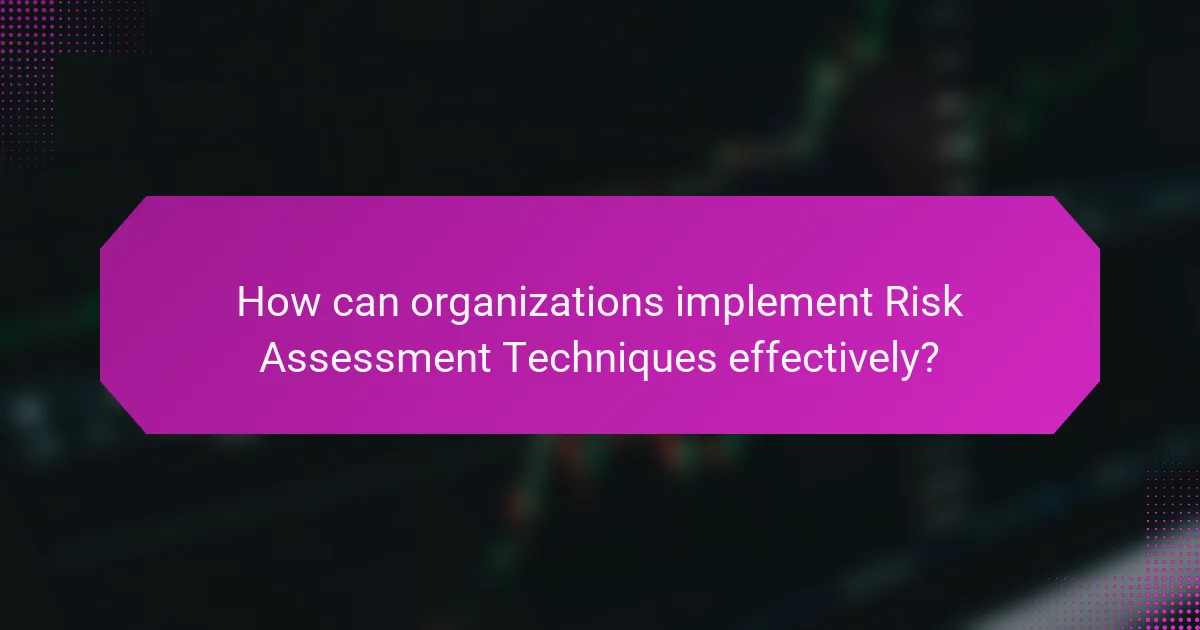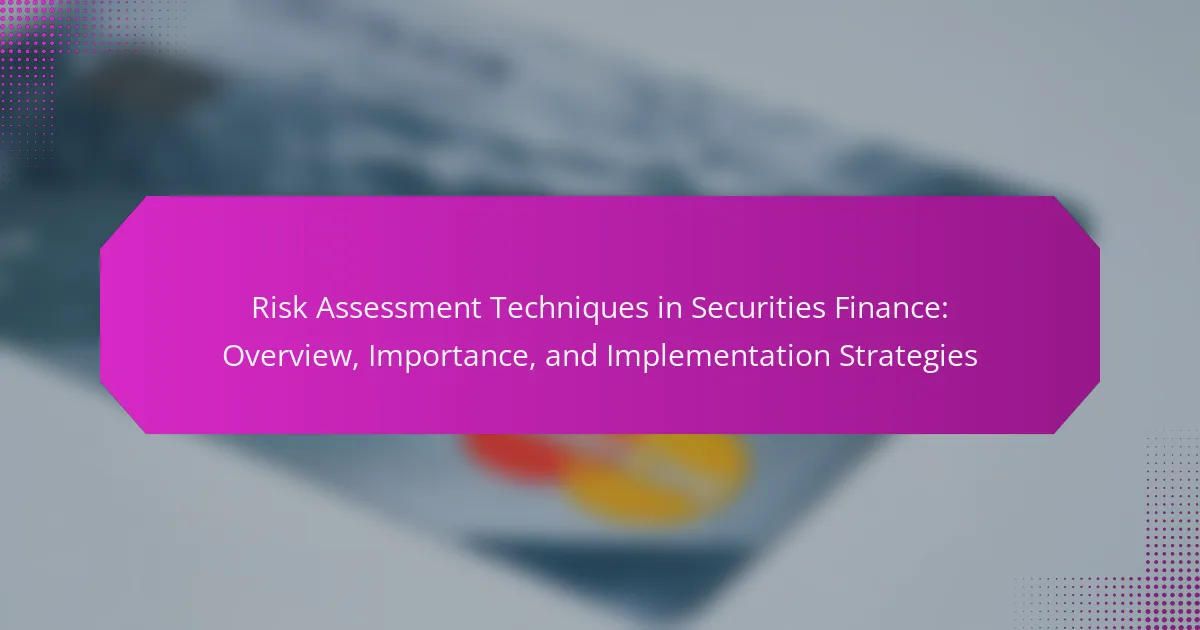Risk assessment techniques in securities finance are essential methodologies for identifying, analyzing, and mitigating financial risks associated with securities transactions. The article outlines various techniques, including quantitative analysis, qualitative assessment, stress testing, and scenario analysis, each serving distinct purposes in evaluating risk exposure and potential losses. It emphasizes the importance of a systematic approach to risk assessment, which involves identifying risks, assessing their likelihood and impact, prioritizing them, and developing mitigation strategies. The article also highlights the significance of training staff in risk assessment processes to foster a culture of risk awareness and improve decision-making, ultimately enhancing organizational resilience.

What are Risk Assessment Techniques in Securities Finance?
Risk assessment techniques in securities finance are methods used to identify, analyze, and mitigate financial risks associated with securities transactions. These techniques include quantitative analysis, qualitative assessment, stress testing, and scenario analysis. Quantitative analysis utilizes statistical models to evaluate risk exposure and potential losses. Qualitative assessment involves expert judgment to evaluate non-numeric factors affecting risk. Stress testing simulates extreme market conditions to gauge the resilience of portfolios. Scenario analysis examines the impact of specific events on securities performance. These techniques are critical in ensuring compliance with regulatory standards and optimizing investment strategies.
How do these techniques operate within the securities finance framework?
Risk assessment techniques operate within the securities finance framework by evaluating potential financial risks associated with securities transactions. These techniques identify, measure, and prioritize risks to mitigate potential losses. They include quantitative methods, such as Value at Risk (VaR), which estimates potential losses under normal market conditions. Qualitative assessments also play a role, focusing on expert judgment and scenario analysis.
These techniques facilitate informed decision-making by providing insights into risk exposure. They enable institutions to implement effective risk management strategies. Regulatory requirements, such as those from the Basel Committee, further emphasize the need for robust risk assessment in securities finance. Accurate risk assessment contributes to overall market stability and investor confidence.
What are the key components of risk assessment techniques?
The key components of risk assessment techniques include risk identification, risk analysis, risk evaluation, and risk treatment. Risk identification involves recognizing potential risks that could affect the project or organization. Risk analysis assesses the likelihood and impact of identified risks. Risk evaluation compares the level of risk against risk criteria to determine its significance. Finally, risk treatment involves selecting and implementing measures to mitigate or manage the identified risks. These components are critical for effective risk management in securities finance.
How do these components interact to assess risk?
Risk assessment in securities finance involves the interaction of various components such as market data, financial models, and regulatory frameworks. Market data provides real-time information on asset prices and trading volumes. Financial models analyze this data to predict potential risks and returns. Regulatory frameworks ensure compliance with laws and guidelines, impacting risk evaluation processes. Together, these components create a comprehensive risk profile. For instance, financial models may adjust based on market data fluctuations. Regulatory changes can also prompt updates in risk assessment methodologies. This dynamic interaction helps in identifying, quantifying, and managing risks effectively.
Why is risk assessment important in securities finance?
Risk assessment is crucial in securities finance because it identifies potential financial losses. It helps organizations understand the risks associated with various securities. This understanding enables better decision-making regarding investments and capital allocation. Effective risk assessment can prevent significant financial downturns. For instance, a study by the CFA Institute found that firms employing robust risk assessment frameworks experienced fewer financial crises. Additionally, accurate risk evaluation enhances compliance with regulatory requirements. This ensures that firms avoid penalties and maintain market integrity. Overall, risk assessment is vital for safeguarding assets and optimizing portfolio performance.
What role does risk assessment play in investment decision-making?
Risk assessment plays a crucial role in investment decision-making. It helps investors identify and evaluate potential risks associated with an investment. By analyzing factors such as market volatility, credit risk, and economic conditions, investors can make informed choices. Effective risk assessment leads to better portfolio management and asset allocation. According to a study by the CFA Institute, 70% of investment professionals prioritize risk assessment in their decision-making process. This emphasizes its importance in mitigating potential losses and enhancing returns.
How does effective risk assessment protect investors?
Effective risk assessment protects investors by identifying potential threats to their investments. It allows investors to understand market volatility and assess the likelihood of losses. By analyzing various risk factors, investors can make informed decisions. This process includes evaluating financial health, market conditions, and geopolitical influences. For instance, a study by the CFA Institute found that effective risk management can reduce investment losses by up to 30%. By implementing robust risk assessment techniques, investors can mitigate risks and enhance their overall portfolio performance.

What are the different types of Risk Assessment Techniques?
Qualitative risk assessment techniques involve subjective evaluation of risks based on expert judgment. Quantitative risk assessment techniques use numerical data to measure risk likelihood and impact. Semi-quantitative techniques combine both qualitative and quantitative approaches for a balanced assessment. Common methods include Failure Mode and Effects Analysis (FMEA), Hazard and Operability Study (HAZOP), and Monte Carlo simulations. Each technique serves different purposes in identifying and mitigating risks in securities finance. These methods are essential for effective risk management and informed decision-making.
How do qualitative and quantitative techniques differ?
Qualitative and quantitative techniques differ primarily in their approach to data collection and analysis. Qualitative techniques focus on understanding concepts, experiences, or phenomena through non-numerical data. This often involves interviews, focus groups, or open-ended surveys. Quantitative techniques, on the other hand, emphasize numerical data and statistical analysis. They typically use structured tools like surveys with closed-ended questions or experiments.
Qualitative techniques provide insights into motivations and behaviors, while quantitative techniques offer measurable and generalizable results. For instance, qualitative research might explore investor sentiment through interviews, while quantitative research could analyze market trends using statistical models. Both techniques serve distinct purposes in risk assessment, enhancing decision-making in securities finance.
What are the strengths and weaknesses of qualitative techniques?
Qualitative techniques have notable strengths and weaknesses in risk assessment. Strengths include their ability to provide in-depth insights into complex issues. They capture nuances and contextual factors that quantitative methods may overlook. Qualitative techniques also facilitate understanding stakeholder perspectives and motivations. This can lead to more informed decision-making in securities finance.
However, weaknesses exist as well. Qualitative techniques often lack generalizability due to small sample sizes. They can be subjective, influenced by researcher bias or interpretation. Additionally, qualitative data may be challenging to analyze systematically. This can lead to inconsistencies in findings. Overall, while qualitative techniques offer rich insights, their limitations must be acknowledged in risk assessment.
What are the strengths and weaknesses of quantitative techniques?
Quantitative techniques have distinct strengths and weaknesses in risk assessment. Strengths include the ability to analyze large datasets efficiently. They provide objective data analysis, reducing bias in decision-making. Quantitative techniques can also identify trends and patterns that may not be visible through qualitative methods. Statistical models can predict potential risks with measurable accuracy.
However, weaknesses exist as well. Quantitative techniques may oversimplify complex situations, ignoring qualitative factors. They rely heavily on data quality, making them vulnerable to inaccuracies. Additionally, these techniques may not account for unexpected market behaviors or events. This limitation can lead to misleading conclusions in risk assessment.
What specific methodologies are used in risk assessment?
Specific methodologies used in risk assessment include qualitative and quantitative analysis. Qualitative analysis involves subjective judgment and expert opinions to assess risks. Techniques such as interviews, surveys, and focus groups are common in this approach. Quantitative analysis uses numerical data to evaluate risks. Methods like statistical modeling, simulations, and historical data analysis are employed. Additionally, frameworks such as the Risk Management Framework (RMF) and Hazard and Operability Study (HAZOP) provide structured approaches to risk assessment. These methodologies ensure comprehensive evaluation and management of risks in various sectors, including securities finance.
How do Value at Risk (VaR) and Stress Testing work?
Value at Risk (VaR) quantifies the potential loss in value of a portfolio over a defined period for a given confidence interval. It uses historical price data and statistical methods to estimate the maximum expected loss. For example, a VaR of $1 million at a 95% confidence level indicates a 5% chance of losing more than $1 million in a day.
Stress Testing assesses how a portfolio performs under extreme market conditions. It simulates adverse scenarios to evaluate potential losses. Stress tests can reveal vulnerabilities that VaR may not capture. For instance, a stress test might model a market crash to see how a portfolio reacts.
Both techniques are essential for risk management in securities finance. VaR provides a baseline for normal market conditions, while stress testing prepares for extraordinary events. Together, they help financial institutions make informed decisions and maintain stability.
What is the significance of Scenario Analysis in risk assessment?
Scenario analysis is significant in risk assessment as it evaluates potential future events by considering alternative scenarios. This technique helps identify vulnerabilities and assess the impact of various risk factors. By simulating different market conditions, organizations can better understand potential losses and develop strategies to mitigate risks. Scenario analysis enhances decision-making by providing insights into how different variables interact under stress. It allows firms to prepare for extreme but plausible events, which is crucial in securities finance. Historical data supports its effectiveness, showing that firms using scenario analysis often experience improved risk management outcomes.

How can organizations implement Risk Assessment Techniques effectively?
Organizations can implement Risk Assessment Techniques effectively by establishing a systematic approach. This involves identifying potential risks associated with securities finance operations. Next, organizations should assess the likelihood and impact of each identified risk. Utilizing quantitative and qualitative methods enhances the accuracy of risk evaluation.
Furthermore, organizations should prioritize risks based on their assessment results. Developing and implementing mitigation strategies is crucial for managing high-priority risks. Regularly reviewing and updating risk assessments ensures they remain relevant to changing market conditions.
Lastly, training staff on risk assessment processes fosters a culture of risk awareness. According to the International Organization for Standardization (ISO 31000), effective risk management can lead to improved decision-making and increased organizational resilience.
What steps should be taken to develop a risk assessment framework?
Identify the objectives of the risk assessment framework. This sets the direction for the entire process. Gather relevant data regarding potential risks. This includes historical data, industry benchmarks, and regulatory requirements. Analyze the identified risks to understand their likelihood and impact. Use qualitative and quantitative methods for a comprehensive view. Develop risk criteria to prioritize the risks. This helps in focusing on the most significant threats. Create a risk assessment matrix to visualize risk levels. This tool aids in decision-making. Document the findings and methodologies used in the assessment. This ensures transparency and facilitates future reviews. Regularly review and update the risk assessment framework. This maintains its relevance in a changing environment.
How can organizations identify relevant risks in securities finance?
Organizations can identify relevant risks in securities finance through comprehensive risk assessments. These assessments involve analyzing market volatility, credit risk, and operational risk. Organizations should utilize quantitative models to assess potential financial impacts. Qualitative analysis, including expert interviews and scenario analysis, also plays a crucial role. Regular monitoring of regulatory changes is essential for identifying compliance risks. Data analytics can help in detecting anomalies that indicate potential risks. Furthermore, benchmarking against industry standards aids in recognizing emerging risks. Implementing a robust risk management framework ensures continuous identification and mitigation of risks.
What tools and technologies support risk assessment implementation?
Risk assessment implementation is supported by various tools and technologies. These include risk management software, which automates data collection and analysis. Examples of such software are RiskWatch and LogicManager. Data analytics tools help in identifying trends and potential risks. Technologies like machine learning enhance predictive analytics by processing large datasets. Additionally, frameworks such as ISO 31000 provide guidelines for risk management practices. Cloud-based solutions enable real-time collaboration and data sharing among stakeholders. These tools collectively streamline the risk assessment process and improve decision-making.
What are best practices for conducting risk assessments?
Best practices for conducting risk assessments include identifying potential risks, evaluating their impact, and prioritizing them. Organizations should engage stakeholders to gather diverse perspectives. They must establish a clear framework for assessing risks based on industry standards. Regularly updating the risk assessment process is essential to reflect changing environments. Documenting findings and action plans ensures accountability and transparency. Utilizing quantitative and qualitative data enhances the accuracy of risk evaluations. Training staff on risk management principles fosters a culture of awareness. Finally, integrating risk assessments into decision-making processes supports proactive risk management.
How often should risk assessments be conducted?
Risk assessments should be conducted regularly, typically at least annually. However, they should also be performed whenever there are significant changes in the business environment or operations. This includes changes in regulations, market conditions, or the introduction of new products. Frequent assessments help identify emerging risks and ensure compliance with industry standards. According to the ISO 31000 standard, risk assessments should be an ongoing process, integrated into the organization’s governance framework. Regular evaluations enhance risk management effectiveness and support informed decision-making.
What strategies can enhance the accuracy of risk assessments?
Utilizing data analytics enhances the accuracy of risk assessments. Advanced analytics can process large datasets to identify patterns and trends. Incorporating historical data improves predictive capabilities. Regularly updating risk models ensures they reflect current market conditions. Engaging cross-functional teams brings diverse perspectives to risk evaluation. Implementing scenario analysis allows for testing various risk factors. Utilizing technology tools streamlines data collection and analysis. Continuous monitoring of risk indicators provides real-time insights for timely adjustments.
How can organizations continuously improve their risk assessment processes?
Organizations can continuously improve their risk assessment processes by implementing regular reviews and updates. This involves analyzing past assessments to identify weaknesses. Organizations should adopt new technologies for enhanced data analysis. Utilizing machine learning can provide deeper insights into risk patterns. Training staff on emerging risks and assessment techniques is essential. Engaging stakeholders in the risk assessment process fosters a culture of awareness. Benchmarking against industry standards helps organizations stay competitive. Lastly, integrating feedback loops ensures that lessons learned are applied to future assessments.
Risk assessment techniques in securities finance are essential methodologies used to identify, analyze, and mitigate financial risks associated with securities transactions. The article provides an overview of various risk assessment techniques, including quantitative analysis, qualitative assessment, stress testing, and scenario analysis, highlighting their importance in regulatory compliance and investment strategy optimization. Key components of these techniques, such as risk identification, analysis, evaluation, and treatment, are examined, along with the interaction of market data, financial models, and regulatory frameworks. The significance of effective risk assessment in safeguarding assets and enhancing portfolio performance is emphasized, alongside best practices for implementation and continuous improvement in risk management processes.
